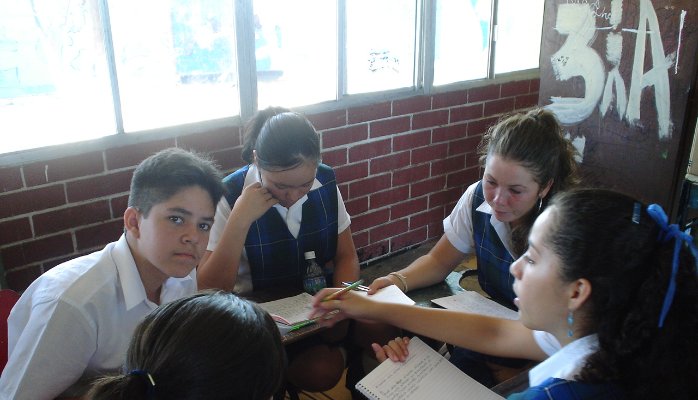
Students doing group work
Where does Learning Take Place?
Whenever I ask this question in my workshops, even seasoned educators tell me that learning takes place in the work that students produce or they gesture to the walls and ceiling, “Here. Learning is all around us.”
Learning isn’t in the classroom or in books or in the work students produce. Learning takes place in the minds of learners. Educators might see evidence of learning, a portfolio, a score on a test or an essay a student wrote. But it’s not so easy to see how a student came to know and understand a concept or a skill through experience and adjustments in schema (behavioral or thought patterns that help organize categories of information and the relationship between these categories). The way to see students’ learning and the way their minds work (you get a two-fer) is to structure learner centered classrooms.
What are Learner-Centered Classrooms?
Essentially, leaner-centered classrooms are places (I’m an advocate of getting out of the classroom) where students help create their own knowledge and understanding, instead of the teacher giving knowledge, say like in a strict lecture format. Put another way, students don’t receive knowledge and understanding from the teacher, but they actively work to increase knowledge, skills and understanding.
4 Tips to Create Learner-Centered Classrooms
In a learner centered-classroom, educators create an environment that encourages students to construct knowledge and understanding. Here are 4 tips on how to create a learner-centered environment.
1. Become a Student in Your Classroom: This more of an attitude than anything else. The idea is to stop seeing yourself as the only provider of learning experiences in the classroom, as the only person students can learn from. You may know a whole lot about the subject you’re teaching. But students in the class offer other perspectives (based on the way they think, where they were born, the languages they speak etc. Some students may actually know more than you do on a particular topic. How do you find out? You ask. Or you leave room for discussion and let students know that they don’t have to agree with everything you say.
2. Ask Lots of Questions (and wait for responses): It’s not so much the questions you ask but when you ask them. Suppose you gave students a game to play or a problem to solve. Once they say they’re done, you ask, “Can you tell me what you did to get your answer?” “How did you do that?
Sometimes students’ work can be difficult to decipher. There may be words, equations and drawings everywhere and a correct answer. But it doesn’t look like anything you modeled in the lesson. When I have asked students to explain, the markings on the page made sense. And sometimes, students had thought of new ways of thinking about an idea or of solving a particular problem.
Also, students’ verbal responses are a great low-risk assessment that lets educators know how students are doing along the way rather than at the end of a lesson or seminar. Based on responses, you can adjust your instruction (back up and teach fundamentals, accelerate, stop here and ask the entire class a question to see what’s going on) to help all students learn and understand.
3. Create a Safe Space: For students and teachers to ask and answers questions and to risk being wrong (or right), the classroom must be a safe space. In a safe space, students and teachers (cause you will relinquish power over learning, and that can be a scary thing) can speak and act (or be still and silent) without fear of ridicule, violence or abuse.
A great way to create a safe space is, on the first day, the entire class and the teacher establish guidelines for interacting with each other during the class session. A volunteer scribe types up the guidelines and everyone agrees before they sign it. I do this in all my classes and I have found that students tend to enforce the guidelines. I seldom need to.
4. Students Learn in Groups and Pairs: This is a great strategy for becoming a student in your own classroom and for letting students teach other students or learn from each other. You want a translation from French to English or you want students to do an example you’ve written on the Smartboard, let them figure it out in groups that you picked at random (if you let them choose, the same students tend to sit together all the time and you want students to mix, have experience with various types of learners).
While they’re figuring the stuff out, you walk around, listen and ask questions. That way, you get to guide students in the right direction if they’re veering off. Group and partner work also lets you sneak in some differentiated instruction. You can peer students who are great at multiplication with students who need a little more help. You can also mix English Language Learners with students who have strong language skills.
That’s All Folks!
I’m sure there are some tips that we missed. Please enlighted us in the comments below.
Some might say that this stuff works best for the humanities and for small class sizes. These tips might be difficult to implement in …oh… an introductory college bio class with a 100 students and two TAs. But there are learner-centered instruction strategies for those large STEM courses too. We just need to get creative. Stay tuned.
Happy teaching! Happy learning! #heidiholder #redloheducation

